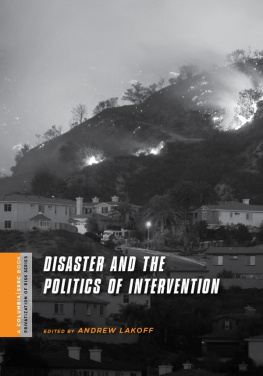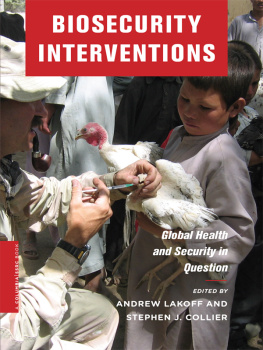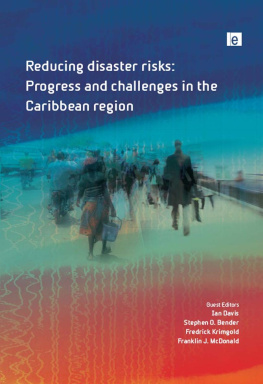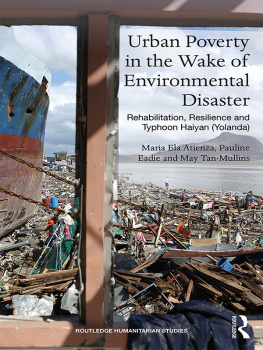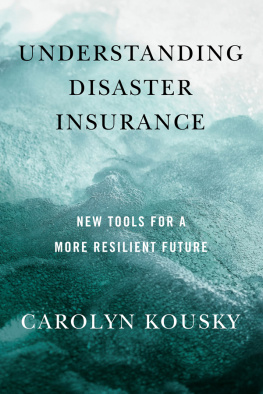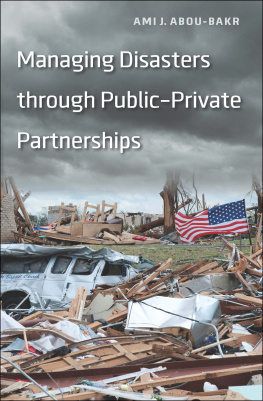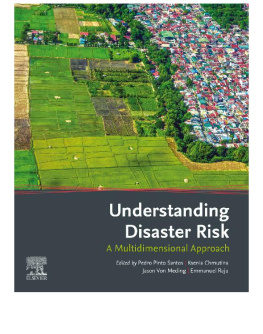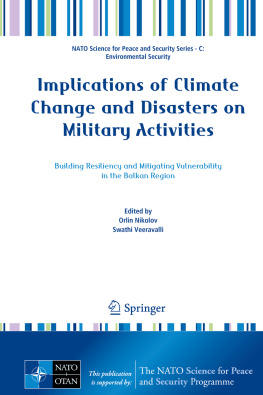DISASTER AND THE POLITICS OF INTERVENTION
The Columbia University Press and Social Science Research Council Series on the Privatization of Risk
THE COLUMBIA UNIVERSITY PRESS AND SOCIAL SCIENCE RESEARCH COUNCIL SERIES ON THE PRIVATIZATION OF RISK
Edited by Craig Calhoun and Jacob S. Hacker
The early twenty-first century is witnessing a concerted effort to privatize riskto shift responsibility for the management or mitigation of key risks onto private-sector organizations or directly onto individuals. This series uses social science research to analyze this issue in depth. Each volume presents a concise review of a particular topic from the perspective of the public and private allocation of risk and responsibility and offers analysis and empirical, evidence-based opinion from leading scholars in the fields of economics, political science, sociology, anthropology, and law. Support for the series comes from the John D. and Catherine T. MacArthur Foundation.
Jacob S. Hacker, ed., Health at Risk: Americas Ailing Health Systemand How to Heal It
Donald W. Light, ed., The Risks of Prescription Drugs
Katherine S. Newman, ed., Laid Off, Laid Low: Political and Economic Consequences of Employment Insecurity
Mitchell A. Orenstein, ed., Pensions, Social Security, and the Privatization of Risk
Robert E. Wright, ed., Bailouts: Public Money, Private Profit
Disaster and the Politics of Intervention
EDITED BY ANDREW LAKOFF
COLUMBIA UNIVERSITY PRESS | NEW YORK
A COLUMBIA/SSSRC BOOK

COLUMBIA UNIVERSITY PRESS
Publishers Since 1893 New York Chichester, West Sussex
cup.columbia.edu
Copyright 2010 The Social Science Research Council
All rights reserved
E-ISBN 978-0-231-51925-0
Library of Congress Cataloging-in-Publication Data
Disaster and the politics of intervention / edited by
Andrew Lakoff.
p. cm.(The Columbia University Press
and Social Science Research Council series on the
privatization of risk)
Includes bibliographical references.
ISBN 978-0-231-14696-8 (cloth : alk. paper)
ISBN 978-0-231-14697-5 (pbk. : alk. paper)
ISBN 978-0-231-51925-0 (ebook)
1. Disaster reliefPolitical aspects. 2. Disaster
reliefGovernment policy. 3. Emergency management
Political aspects. 4. Emergency management
Government policy. 5. Intervention (Federal government)
I. Lakoff, Andrew, 1970 II. Title. III. Series.
HV553.d548 2010
363.34'8dc22
2009049463
A Columbia University Press E-book.
CUP would be pleased to hear about your reading experience with this e-book at .
References to Internet Web sites (URLs) were accurate at the time of writing. Neither the editor nor Columbia University Press is responsible for URLs that may have expired or changed since the manuscript was prepared.
Design by Julie Fry
Cover by Vin Dang
CONTENTS
Introduction
ANDREW LAKOFF
CHAPTER ONE
Beyond Calculation | A Democratic Response to Risk
SHEILA JASANOFF
CHAPTER TWO
Private Choices, Public Harms | The Evolution of
National Disaster Organizations in the United States
PATRICK S. ROBERTS
CHAPTER THREE
Strange Brew | Private Military Contractors and Humanitarians
P. W. SINGER
CHAPTER FOUR
Risking Health | HIV/AIDS and the
Problem of Access to Essential Medicines
HEINZ KLUG
CHAPTER FIVE
Constructing Carbon Markets | Learning from
Experiments in the Technopolitics of Emissions Trading Schemes
DONALD MACKENZIE
Its laissez-faire until you get in deep shit.
John Gutfreund, former CEO of Salomon Brothers1
In late October 2007, a series of wildfires raged uncontrollably in Southern California, surrounding the suburbs of Los Angeles and San Diego and moving rapidly toward the urban core of San Diego. Over half a million residents were evacuated from their homes, a federal emergency was declared, the U.S. Marines and National Guard were mobilized, and President Bush flew to the region to demonstrate the governments commitment to those in need. A combustible mixture of gusting winds, heat, and stores of dry brush was blamed for the conflagration. But as a number of commentators noted, the magnitude of the disaster could not be attributed solely to these forces of nature. The scale of the firestorm also pointed to the San Diego regions failure to enact regulatory measures or devote public resources that would mitigate wildfire risk. The regions politicians had been unwilling to implement zoning regulations to stem rapid housing development into the parched backcountry where fire risk was especially high. And San Diego voters had declined to fund improvement to the citys strapped fire department, even in the wake of catastrophic wildfires that had swept through San Diego County four years earlier.
A relatively minor but telling episode during the 2007 fires pointed to a central issue in this volume: the role of public-sector intervention in mitigating the risk of catastrophe. As local firefighters, overwhelmed by the firestorm, awaited assistance from other regions, the Wildfire Protection Unit of American International Group Inc. (AIG) passed through barricades to protect specific properties in the wealthy northern suburbs of San Diegothose houses belonging to members of AIGs Private Client Group, for which membership cost an average of $19,000 per year. Whether the flames would destroy the homes of area residents thus potentially depended on how much they had paid for private insurancea throwback to the nineteenth century, before governments took on the responsibility of firefighting in the United States.
AIG would, of course, become infamous a year later, when it found itself at the center of another conflagration. This time the disaster was far more widespread: a global financial crisis whose scale and catastrophic potential outstripped the worst scenarios envisioned by economic planners. The insurance giants reckless entry into the under-regulated market for mortgage-backed securities was widely cited as one source of the financial systems calamitous failure. Analogies were made to the great crash of 1929. Some analysts suggested that the nationand the worldwas facing a period of economic decline that would rival the Great Depression. Government officials worked feverishly to assuage an anxious public and to enact regulatory reforms and stimulus measures to keep the financial firestorm from spreading. Soon after inheriting this crisis, newly inaugurated President Barack Obama warned that a failure to act boldly could turn crisis into catastrophe.2 But according to what norms would new regulations to protect against catastrophe be developed? And what kind of institution could be created that would have the power to monitor and intervene in potential financial disaster across the globe?
Such questions were salient across multiple domainsnot only to the financial system, but also to environmental, health, and security risks. Indeed, the first decade of the twenty-first century was punctuated by a series of domestic and international emergencies, each of which challenged extant means of governmental intervention. To list a few of the most visible such events: the terrorist attacks of September 11, 2001, and the anthrax letters that followed; the 2004 tsunami that devastated huge areas of south and Southeast Asia; the flooding of New Orleans in the wake of Hurricane Katrina in 2005; and ongoing calamities, such as the intensifying AIDS pandemic in the global South and the brutal conflict in Darfur, that continued to provoke calls for urgent intervention.

